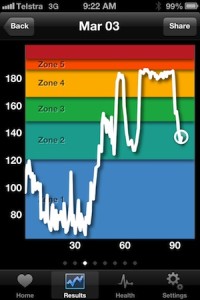I conducted the second field test midway through a 12-week periodized cycling clinic this morning. One student came up with a HR that was slightly lower than the first test, but had big swings in her HR throughout the test. She was confused, as many students would be. Here is how I answered her question and gave her goals to work toward, helping her understand how she can improve the next time we do this field test in 5 weeks.I am midway through a 12-week periodized cycling clinic at my club. Today was our second of three field tests, one at the beginning, one in the middle, and one at the end. Leading up to today’s field test, we have been mostly working sub-threshold, primarily in Zone 3, with a few forays up to Zone 4 (threshold is the top of Zone 4). The past 3 weeks I’ve added threshold intervals, gradually increasing the length and reducing the number. Last week was 3X8 minutes; the week before was a pyramid of 4, 5, 6, 5, 4 minutes; the week before that was 4X4 minutes.
Ellen is fairly new to cycling outside; she’s been doing it just a few years. At the end of last summer she bought her first really nice, new bike. Her previous one was an entry-level used bike, so she could decide if it was something she wanted to pursue. She would like to get more fit so she can tackle some of the many big climbs we have here in Rocky Mountains of Colorado.
Ellen has been coming to my indoor cycling classes for a couple of years, but this is the first year she’s taking my periodized cycling clinic. In the first field test, her average for the 20 minutes was 153, with a maximum of 175. That’s a big range! When you see that much of a heart rate swing, 20 beats above the average, it means she really went extra hard, much harder than she should have. If 153 was the average, that also means that she had data points below 153, possibly quite a bit below.
153 was the LT number she has been using for the first 6 weeks of the program. This morning, we did our second field test and her results were pretty much the same. Average of 151 with a maximum of 175. She was worried that her LT had dropped, and I explained that 2 beats is not significant, and that with such big swings, it’s very difficult to be very accurate. I told her we would continue to use her results from the first test for the remainder of the clinic. I also gave her some goals to work on.
Over the next 5 weeks, prior to our final field test, I asked her to pay extra attention to the percevied exertion at threshold, so she can zero in on it without the HR monitor. By becoming intimate with those sensations of effort, she can target her training much better. Since we will start working above threshold beginning next week, she will also zero in on those sensations of effort a few beats above LT, and 5 beats above, and 10 beats above, etc. In other words, anaerobic efforts.
In preparation for our next field test, her goal will be to reduce the large fluctuations of heart rate in the test. Instead of 20-beat swings, we want more like 4–5 beat fluctuations, or even less as you get more familiar with field testing. This will make the results much more reliable. Those sensations of total breathlessness that you feel above threshold, the ones that force you to back off, are to be avoided when doing a field test. In Ellen’s case, a heart rate of 175 early in her test would have been certain breathlessness.
When I explained this to her (again!) her question to me was, “But didn’t you want us to go as hard as possible?” Sure, you want to go as hard as possible for the full 20 minutes, but the operative word is SUSTAINABLE hard effort, not very hard, then back to moderate, then up to very hard, then back to moderate. It should be hard-hard-hard-hard throughout the whole 20 minutes. I posted this image on the last article about field tests, but it’s even more appropriate now.
I showed this image to Ellen, highlighting the fairly even effort that is evident in this person’s test. If she had this app, her HR would have been all over the chart during the test. She really seemed to get it this time and sent me an e-mail thanking me and looking forward to the next 5 weeks and the final field test.

You may find that you repeat yourself over and over to some of your students when you begin (or even long after you’ve begun) doing field tests. But that is OK! It means they are trying. Keep on explaining, keep on giving them examples, and keep on encouraging them to give it their all.
I’ll report back in 6 weeks when my clinic is over and let you know how Elen did on her third test. I’ll have a few more stories to share with you about all of my students’ successes. Hopefully, you can take these examples and apply them when your students ask you similar questions. Because they will.
If you have done field tests and have been stumped by some of your students’ questions, post them below and I’ll try to answer them for you.

